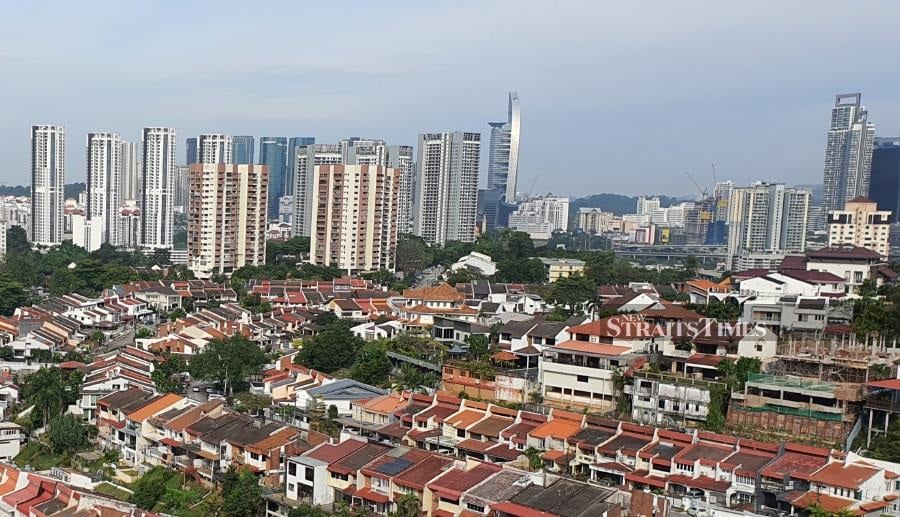
Overview of the Malaysian property market in 2022
The Malaysian property market was able to stage a quick recovery from the pandemic-induced slowdown in 2020 as statistics compiled by the Valuation & Property Services Department of the Ministry of Finance (JPPH) indicated that the volume and value of property transactions recorded an improvement in 2021 and this trend continued into 2022.
Residential Sector
The performance of the residential property market in Malaysia showed a significant improvement in the first nine months of 2022 as the volume of transactions climbed 34.6 per cent compared to the corresponding period in 2021 whilst the value of the transactions went up by 34.8 per cent, building on the momentum of the recovery which started in 2021. The recovery of the residential market is also reflected by the substantial increase in the value of loans approved for the purchase of residential property, as reported by Bank Negara Malaysia.
MORE NEWS
- Bosch records RM727 mil sales in 2022, maintains positive outlook for 2023
- IJM Land, Network Rail to explore developing several sites in UK
- Thai police identify group behind bomb blast on rail tracks
- Petronas 2023-2025 industry outlook remains positive
Residential sector – Factors to watch in 2023
a) Bank Negara Malaysia (BNM) has raised the OPR four times this year and this has increased borrowing costs for the purchase of a property. Economists are of the view that there may still be further increases in 2023 before BNM feels that it has reached the limit for interest rate increases in its efforts to control inflation. The rate increases will bring interest rates back to pre-pandemic days and raise borrowing costs and this may have some impact on demand for the property although not expected to be major. The conclusion of GE15 and the formation of a unity government will hopefully, put a stop to the political instability of the past three years and create an environment that will be able to attract more investors as well as promote economic growth and well-being of the people.
b) The new government will have the opportunity of reviewing and improving the budget 2023 proposals which have been tabled by the previous administration but not yet debated and approved by parliament
c) The increase in construction costs has made property developers adopt a more cautious stance and delay the launching of new projects or stagger the launches in smaller phases until they see a stronger recovery of the property market.
d) The labour shortage is affecting the construction industry and this has resulted in not only delays in completing projects but also an increase in construction costs.
e) Some international economists have predicted a global recession to happen in 2023 and if their predictions come true, Malaysia’s economy will be impacted and this will ultimately affect the property market negatively. However, local economists believe that Malaysia will not enter a recession although the rate of growth is expected to slow down.
f) The residential property market is expected to face some headwinds and challenging conditions in 2023 and will probably register a slight slowdown in its pace of growth but is not likely to reverse gears along its recovery path.
Bright Spots for 2023
a) The focus of the residential property market in 2023 will continue to be on:
• landed residential properties
• high rise apartments in the affordable price range of around and under RM 500,000 in popular locations.
• smaller sized units which will bring down the absolute price of the unit
• niche high-end projects in good locations
b) The removal of the strict MCO SOPs and allowing foreigners to enter the country without having to quarantine for some time, will help to boost not only the retail, leisure, and entertainment industries but also probably, the property sector.
c) The beginning of the move by China, to relax its strict zero covid policy will help to boost the economic growth of the country and this will have beneficial spinoff effects on Malaysia as the country is Malaysia’s largest trading partner. However, there is at the same time, concern that the influx of tourists from China may lead to an increase in Covid infection rates which may then result in stricter SOPs being reinstated.
Office sector
The office sector continued to record a decline in occupancy rates due to the substantial increase in supply without any corresponding increase in demand. Nevertheless, rental rates which registered a drop in 2020 appeared to have stabilised in 2021 / 2022 with the reopening of the economy and return to normality.
Factors to watch for the Office market in 2023
• Concerns of an oversupply of office space in the Kelang Valley will continue to be a major concern and the imminent completion of several mega office projects in the coming one to two years will worsen the oversupply situation
• Companies that are wary of being caught again in another business slowdown have adopted a more flexible approach and opted for co-working space instead of signing long-term tenancies for permanent office space for expansion purposes.
• Multinational as well as local companies have placed increasing importance on environmental, social, and governance (ESG) issues, and in response, more new office buildings will adopt designs that will comply with ESG requirements to attract such tenants.
Bright Spots for 2023
• The recovery of the economy which led to improved business conditions in 2021 / 2022 has allowed companies to recover from the business slowdown that they suffered during the height of the pandemic. Some companies have done well enough to consider expanding or relocating to bigger office premises and this has generated increased demand for office space.
• The looming oversupply situation may lead to some developers rethinking their new office projects and shelving or deferring them. This will help alleviate the oversupply situation.
• The first nine months of 2022 have seen an increase in DDIs as well as FDIs in the country. This will spur economic growth which in turn, will lead to business expansion and benefit the office market.
• The growth of fintech companies will spur increased demand for office space
• More office workers have returned to work in their offices although some companies have continued to adopt a hybrid system of work from home/work in the office.
• Despite the looming oversupply, rental rates have generally stabilised
Retail Sector
When the country exited the pandemic phase and loosened the strict SOPs put in place during the various MCOs and domestic and international travel was allowed, shopping traffic recovered in the malls and the retail industry was able to move out of the worst performing period of its history. Nevertheless, although footfalls in malls have improved significantly, occupancy and rental rates of malls have yet to get back to pre-covid levels.
There are a total of 1,069 shopping malls in Malaysia as of Q3 2022 with a total nett floor area of 17.44 million sq ft. The malls recorded an average occupancy rate of 75.2%, continuing the decline which started when the pandemic hit the country in 2020.
The retail sector recorded a strong recovery in 2022 with retail sales performance registering double-digit growth with the highest expansion recorded in Q3. However, it has to be pointed out that this performance was achieved on the back of a low base due to the poor performance recorded during the pandemic hit period of the past two years. Overall, retail sales are projected by Retail Group Malaysia to grow by around 41.6% for the full year 2022.
Outlook for 2023
The biggest challenges facing the retail industry are the substantial rise in prices of goods and services, the shortage of staff, and the increase in the supply of retail floor space with the completion and impending completion of several new malls, especially in the Klang Valley and the possibility of a global economic slowdown which will hurt the country’s economy and lead to consumers turning cautious in their spending. The lifting of travel restrictions after China relaxed its zero covid policy is good news as it could increase tourist arrivals to the country which in turn, could lead to more footfalls and sales recorded by malls in the main cities visited by Chinese tourists. The conclusion of GE 15 and the forming of a unity government and the resultant return to political stability for the country also augurs well for businesses. If the calmer political situation can be sustained for the full term of the present government, this would help to promote consumer confidence and spending. Overall, the retail sector should continue to see an improvement in 2023 but the pace of growth could be affected by the global recession depending on its severity and duration if it does happen as predicted by some economists.
Industrial sector
Industrial property transactions in Malaysia have registered a sharp increase of 57.5% in volume and 34.9% in the value of transactions in the first nine months of 2022 compared to the same period in 2021. This puts the industrial property sector as the best-performing sector.
Factors to look for in the industrial property market in 2023
a) The industrial sector is driven by the e-commerce sub-sector which has generated demand for distribution hubs, warehousing, and logistics facilities which are strategically located near high-population areas and served by a good network of highways to enable fast point-to-point delivery to consumers. There has been a huge increase in demand for online transactions since the start of the pandemic (although this has tapered off somewhat in 2022) and this has provided a boost in demand for warehousing & logistics facilities
b) Data centres are still sought after.
c) Matured and established areas with good accessibility and proximity to the source of labour will remain a popular locations for manufacturers or warehouse operators
Bright spots for 2023
a) Consumers have returned to their normal pre-covid routines and this has led to an improved environment for businesses
b) All economic sectors have now been allowed to open and this will permit businesses, including manufacturers and logistics operators to resume normalized operations.
c) International borders have opened up and international travellers are allowed into the country without having to go for any covid testing or quarantine. This will ease and facilitate business as well as leisure travel.
a) Malaysia has continued to record a good trade performance over the past two years. This will provide a boost to demand industrial properties. However, this may be affected by any global recession.
b) The increase in the inflow of FDIs, especially in the manufacturing sector is expected to translate into an increase in demand for industrial space /properties
c) Industrial activities are still active and several major industrial property transactions have been noted in the course of the past two years.
Hospitality sector
Since the reopening of Malaysia’s international borders in April 2022, international tourists have started to return to the country. Statistics from the Ministry of Tourism, Arts & Culture (MOTAC) showed that the number of tourists in the first seven months of 2022 exceeded 3 million which is 23 times that for the full year 2021 when the country still experienced periods of lockdowns and 56 times more than the number of tourists in the same period in 2021. However, this is still much lower than the figures which the country had been recording in the pre-covid years eg. 25.8 million in 2018 and 26.1 million in 2019 and more needs to be done by the government to increase the inflow of tourists into the country.
Based on MOTAC’s statistics, the average occupancy rates of hotels in Malaysia in the first six months of 2022 improved to 43.6% from 23.2% for the same period in 2021. All states recorded an increase in average occupancy rates except for Sarawak. The east coast states of Pahang, Trengganu, and Kelantan recorded the highest occupancy rates. The improvement in occupancy rates can be attributed partly to the efforts of the government to promote
domestic travel and the preference of Malaysians to holiday within the country rather than travel abroad, especially in the early part of the year when travel restrictions and more stringent SOPs were still in place in Malaysia as well as in other countries.
Hospitality sector – Factors to watch in 2023
a) Domestic tourism will continue to play a big part in boosting hotel occupancy rates in the country
b) With the reopening of international borders, we have seen an increase in the number of tourist arrivals but the figure is still way below pre-covid levels
c) After the long periods of lockdowns experienced in 2020 / 2021 and with the reopening of international borders and easing of quarantine requirements by most countries, Malaysians have now started to travel abroad again for their year-end annual holidays
d) The possibility of a global recession in 2023 could lead to travel plans being shelved and this may affect tourist arrivals into the country.
e) The shortage of labour which has plagued the country over the past year is a major issue faced by the hospitality industry and if not resolved by the new government, will continue to hamper the recovery and growth of the hospitality industry.
f) There are quite several new hotels being built especially in the Klang Valley and when completed over the next few years, will add significantly to the supply of hotel rooms. There is therefore a need for the government to take concerted and proactive steps to promote the country and increase the inflow of international tourists into the country.
Bright spots for 2023
a) With the general elections over and a new government in place, we should see an improvement in investment sentiments and this could lead to more foreign businessmen travelling to the country in pursuit of business opportunities
b) With the loosening of travel restrictions internationally, will allow MOTAC to draw up and implement new plans to promote the tourism industry, including reactivating the shelved Visit Malaysia Year 2020. As it is, the government has revised the tourist arrival targets to 9.2 million for 2022 and 15 million for 2023.
c) The re-opening of China’s borders could lead to an influx of Chinese tourists into Malaysia and this will benefit the retail as well as hospitality & entertainment sectors. Nevertheless, there are concerns that the influx of tourists may lead to an increase in covid infections which could then lead to the reimposition of strict covid health protocols. – Story courtesy of Henry Butcher Malaysia.
Credits
By HENRY BUTCHER MALAYSIA – January 10, 2023 @ 1:22pm
Article from News Strait Times / Article dated 10 January 2023
We would like to give credit and express our gratitude to the original authors of this article – Malaysia property outlook 2023, which we have included on our website. The content of this article belongs solely to the talented writers at News Strait Times, and we are utilizing it for display purposes without any form of plagiarism or modification.
We value and respect the hard work, dedication, and research that went into creating this article. By featuring it on our website, we aim to provide our readers with valuable information and insights from reputable sources.
We encourage our visitors to visit https://www.nst.com.my/ to explore more of their outstanding articles and support their exceptional journalistic endeavors.
Thank you, https://www.nst.com.my/, for your contribution to informing and enlightening readers around the world.
Link to original article:
https://www.nst.com.my/property/2023/01/868922/malaysia-property-outlook-2023














